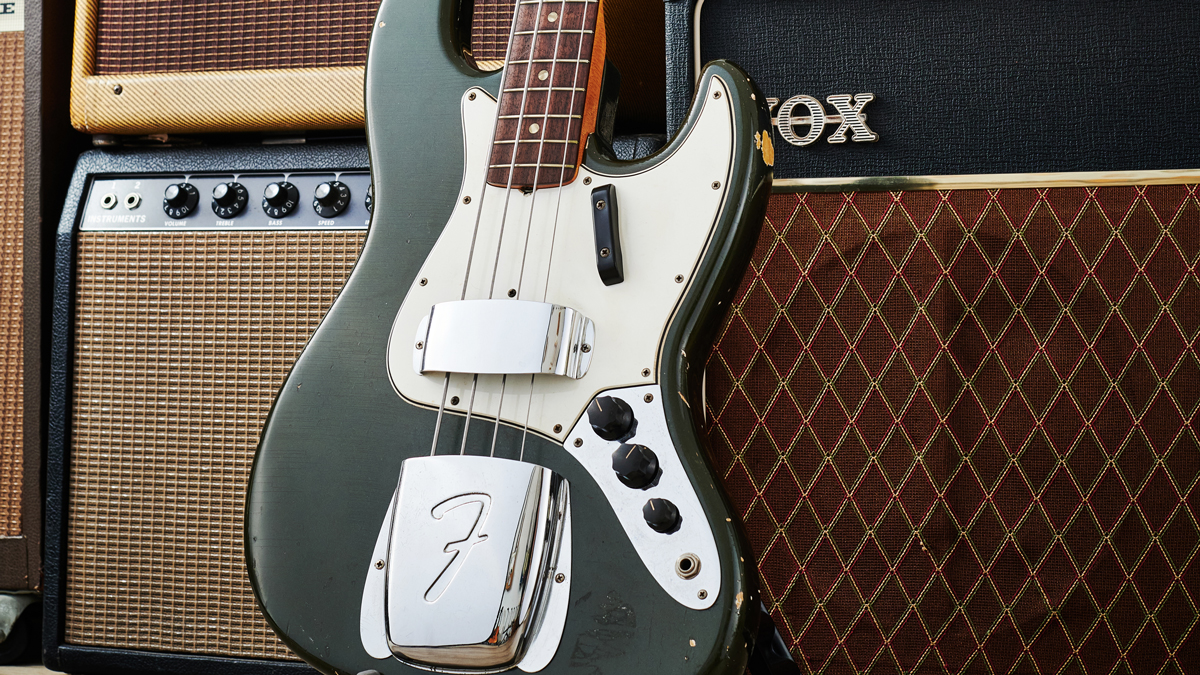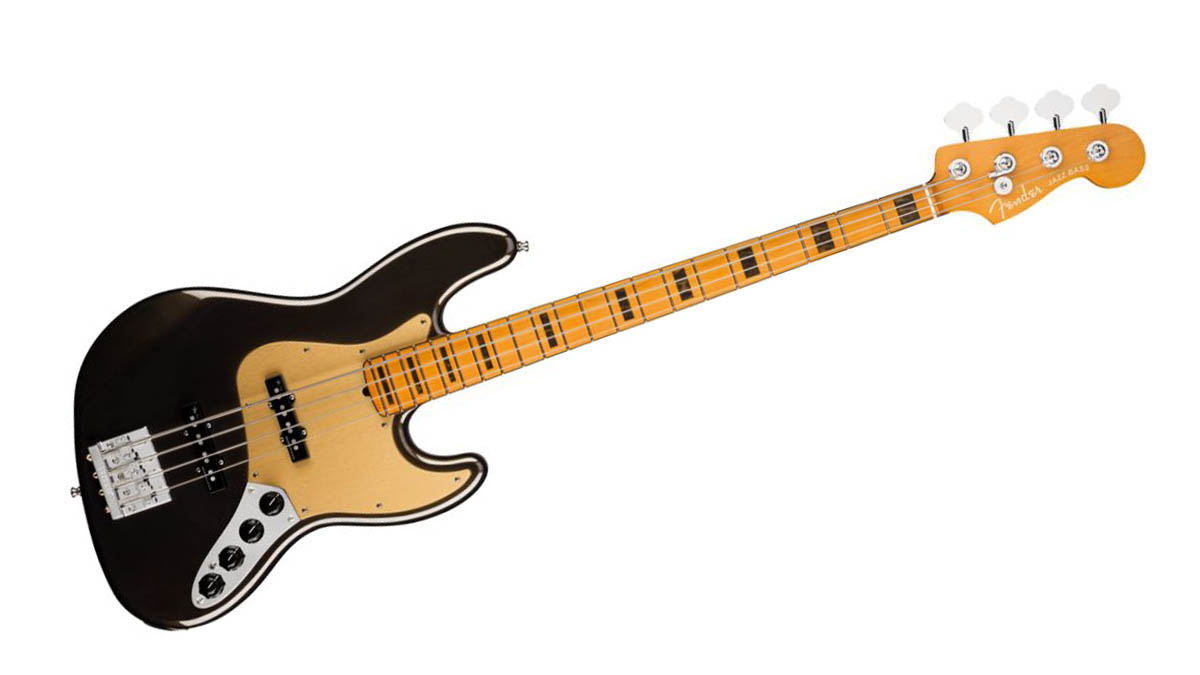60 years of the Fender Jazz Bass
We meet Allen Abbassi, Senior Product Development Manager, for a look back – and forward – on the subject of the mighty J...

When Leo Fender first drew up the plans for the Precision Bass in 1951, 70 years ago next year, who knows if he had a second, iconic bass model planned for release just nine years later?
When the Jazz Bass debuted in 1960, it was initially advertised as the ‘two-pickup Precision’, but this it most certainly wasn’t. The Precision gets its distinctive sound from the over-wound split-coil pickup – more like a humbucker – while the Jazz was and remains equipped with a pair of single-coil units.
Furthermore, the J body combined elements of Fender’s Stratocaster and Jazzmaster guitars to provide a twin-cutaway design, set at an offset angle with a startlingly narrow neck and fretboard. This created a visual sleekness about the Jazz design that also added comfort and ease of play.
Initially, its pickups were adjusted by a pair of dual concentric – or ‘stacked’ – knobs, but these could be unreliable, so were soon replaced by the two volumes and one tone control that we’re familiar with today. The Jazz has proved to be remarkably adaptable to changes in musical trends in bass playing, and most session players own one.

This is due largely to the incredible flexibility of sound that can be achieved from having two identical pickups with individual volumes: by varying the quantity of signal produced by each pickup a myriad subtle tonal changes become available –and, as if by magic, the so-called ‘sweet spot’ appears. This is where the bass actually seems to sing.
This was a sound that Jaco Pastorius exploited to the full with jazz-fusion pioneers Weather Report, but this blending ability also allows for extra note definition, even when you’re using a predominantly bassy sound.
John Entwistle found the Jazz’s extra treble ideal for defining the Who’s unique sound; Jimi Hendrix Experience bassist Noel Redding also took advantage of the bass’s clarity when he needed to hold the band together during drummer Mitch Mitchell’s wilder moments. As a former guitarist, Redding also preferred the slimmer dimensions of the Jazz neck.
Get The Pick Newsletter
All the latest guitar news, interviews, lessons, reviews, deals and more, direct to your inbox!

John Paul Jones and Norman Watt-Roy also favored the Jazz for Led Zeppelin and the Blockheads respectively, for its deep tone and clear note definition.
Understandably, Fender couldn’t resist a degree of cross-pollination over the years for both P and J models. The Precision was embellished with an added Jazz pickup or a pair of split-coils, and many were offered with thinner necks. The Jazz, however, has tended to stay truer to its origins, although it has found favor in a five-string configuration.
Recently, Fender launched the 60th Anniversary Jazz, celebrating this momentous milestone. Whatever may come in the future, it’s undeniable that the J-Bass is an all-time classic – which encouraged us to ask Fender’s Allen Abbassi how he hopes to improve on its design now that it’s hit 60.

Allen, it seems that no time has passed since the release of the 50th Anniversary Jazz in 2010. How does the 60th Anniversary model differ?
“That’s a very good question. You don’t improve on it – you just do a different version. One of the things that people like to talk about with Leo Fender’s designs is that each time he came out with one of his classic models, he nailed it right out of the gate. He basically made it perfect right when it came out, so when we do reissues and anniversaries we sometimes do different modern takes, and sometimes we just like to do a true reissue.
“That’s what we’ve done this time, with the concentric knobs, because we decided to go back to the early style of Jazz, combining that knob configuration with pearl dots and tortoiseshell that would have come out in 1964, and the neck binding that came out in ’65, so it’s a mish-mash of the early to mid-Sixties configurations of the Jazz bass.“
Do you make those decisions based on a focus group of bassists, or just on your own expertise?
“It’s a mix. I talk to a lot of musicians because of my position, and I’m always at trade shows and talking to artists, so I get to hear people saying ‘I prefer dots to blocks’, for example. I also hear that the concentric knob configuration is a really cool, flexible setup but that it’s really hard to find, so we take all of that feedback and apply it to the products. In this instance, we’ve taken things that Fender already did, and made sure that it’s right.“
How many 60th Anniversary Jazz basses are you planning to make?
“It’s not limited in quantity, but it is limited in time, because we’re planning to make them until the end of 2020. It’ll be between 500 and 1000 basses. Basses at this price point usually top out at around 500 or 600, and the anniversary models do a little more than that, because they’re collectable.“
As design and manufacturing technology is so advanced these days, could you arguably claim that these basses are better than the originals?
“Actually, I have heard people say that. There’s no question that the consistency of our construction is much better than it was back in the day. We talk about the consistency of the magnet wire, and of our winding machines, and the consistency of the alnico metal, because there were days when Leo just threw magnets in a pickup because they ran out of one magnet and just switched to another.
“Honestly, that’s one of the reasons why some of the magnet wire changed, because they ran out of them and decided to use another. Or maybe because it was cheaper – he was very utilitarian and he was always looking for cost-cutting measures. Sometimes he switched to alder because it was cheaper and easier to paint, because they didn’t have to grain-fill it.
“These were utilitarian decisions, not tone decisions, but they became canonized as the decisions that were made for specific reasons of tone.
If you pick up 10 Jazz basses from 1960, and measure the output of the pickups, you might get 10 different outputs
Allen Abbassi
And it all became part of the Fender lore?
“Exactly. So with today’s manufacturing methods, we’ve got it down to a science, after 70 years of doing this on the assembly line. We can crank out basses, and each one is very close to the last. Our tolerances are tighter, our finishes are more consistent, the pickups are wound more consistently...
“If you pick up 10 Jazz basses from 1960, and measure the output of the pickups, you might get 10 different outputs. Now, whether the new basses are better or not, that’s for the player to decide, because when a bass ages, that does something to the quality of the tone.“
Is there a secret vault somewhere at Fender containing a single example of every Jazz variant ever made?
“I really wish there was, because every time we start work on another reissue model from a specific year, we don’t have a vault to go to. Fortunately we have a lot of friends in the business who have vaults of their own that they let us sift through. No-one at Fender imagined back in the Sixties that basses from that era would be worth up to $100,000 in 2020, so nobody started collecting them, and I really wish they had!“
Joel McIver was the Editor of Bass Player magazine from 2018 to 2022, having spent six years before that editing Bass Guitar magazine. A journalist with 25 years' experience in the music field, he's also the author of 35 books, a couple of bestsellers among them. He regularly appears on podcasts, radio and TV.
“An esoteric boutique vibe, superb ergonomics and a powerful, unique preamp – Tobias is back”: Tobias Growler IV review
“Affordable versions of the three best basses I've ever held in my hands”: Sterling by Music Man completes its trilogy of Joe Dart signature models with a trio of made-to-order basses that cost less than $500












